文章目录
-
- 1.list 底层
- 2. list的模拟实现
-
- 1. list_node 类设计
- 2. list类如何调用类型
- 3 .push_back(正常实现)
- 4. 迭代器的实现
-
- 第一个模板参数T
- const迭代器
- 第二个模板参数Ref
- 第三个模板参数Ptr
- 对list封装的理解
- 5. insert
- 6.push_back与 push_front(复用)
- 7. erase
- 8. pop_back与pop_front (复用)
- 9. clear 清空数据
- 10. 迭代器区间构造
- 12. 拷贝构造
-
- 传统写法
- 现代写法
- 13. 赋值
- 3.完整代码
1.list 底层
list为任意位置插入删除的容器,底层为带头双向循环链表
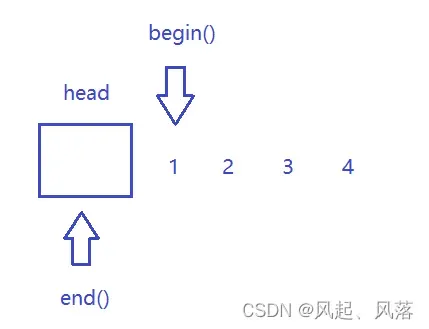
begin() 代表第一个结点,end()代表最后一个结点的下一个
2. list的模拟实现
1. list_node 类设计
template<class T>
struct list_node
{
list_node<T>* _next;
list_node<T>* _prev;
T _data;
};
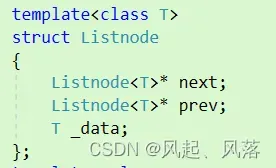
C++中,Listnode作为类名,而next和prev都是类指针,指针引用成员时使用->,而对象引用成员时使用 .
通过显示实例化,将两个类指针指定类型为T
2. list类如何调用类型
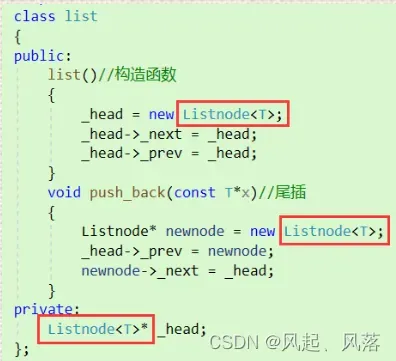
Listnode 代表类型
Listnode 代表类名 + 模板参数 才是类型
而_head 以及创建新节点前都需加上类型
3 .push_back(正常实现)
void push_back(const T&x)//尾插
{
node* newnode = new node(x);
node* tail = _head->_prev;
tail->_next = newnode;
newnode->_prev = tail;
newnode->_next = _head;
_head->_prev = newnode;
}
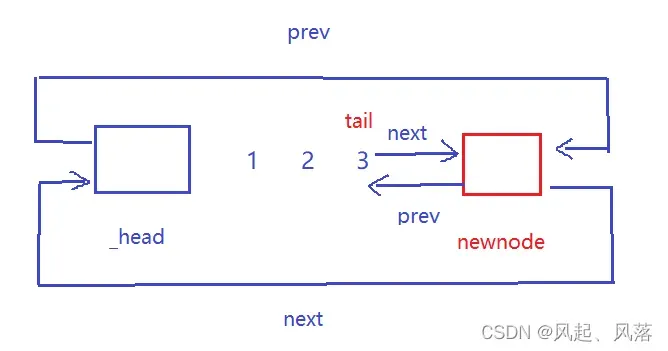
当我们想要创建一个节点时,需要调用node的构造函数
typedef list_node node ,node是由 list_node 类提供的
list_node(const T& x=T())//list类的构造函数
:_next(nullptr)
, _prev(nullptr)
, _data(x)
{
}
最好在构造函数处提供全缺省,对于内置类型int可以使用0,但对于自定义类型来说就不可以,所以为了满足泛型的要求,使用匿名对象调用默认构造函数
4. 迭代器的实现
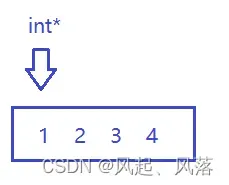
若在数组上有一个int类型的指针,解引用是int类型的数据,再++可以加载下一个位置,因为物理空间是连续的

同样若在链表上,解引用类型为 node,再++不能到下一个节点,因为物理空间不连续
所以构造迭代器通过封装节点的指针来进行构造 (后面会讲)
第一个模板参数T
创建一个_list_iterator的类,来实现迭代器功能
template<class T>
struct _list_iterator
{
typedef list_node<T> node;
typedef _list_iterator<T> self;
node* _node;
_list_iterator(node* n)
:_node(n)
{
}
T& operator*()//解引用
{
return _node->_data;
}
_list_iterator<T>& operator++()//返回迭代器
{
_node = _node->_next;//指向下一个节点
return *this;
}
bool operator!=(const self&s)
{
return _node != s._node;
}
};
在list类中,调用迭代器实现begin()和end()功能
typedef _list_iterator<T,T&,T*> iterator,
通过typedef 将_list_node类模板定义为iterator
iterator begin()
{
return iterator(_head->_next);//通过匿名对象访问第一个数据
}
iterator end()
{
return iterator(_head);//通过匿名对象访问最后一个数据的下一个
}
在list类中实现begin()和end(),内部调用_list_node类的构造函数

const迭代器

假设第一个代表的是T * ,而第二个代表的 T * const,保护迭代器本身不可以被修改,而我们想要保护迭代器指向的内容不可被修改即 const T*
复制_list_iterator类中的内容,并将名字修改为const_list_iterator
只需修改*operator类型为cosnt T& ,说明解引用后的数据返回不能被修改
template<class T>
struct _list_const_iterator
{
typedef list_node<T> node;
typedef _list_const_iterator<T> self;
node* _node;
_list_const_iterator(node* n)
:_node(n)
{
}
const T& operator*()//解引用
{
return _node->_data;
}
self& operator++()//前置++
{
_node = _node->_next;//指向下一个节点
return *this;
}
self& operator++(int)//后置++
{
self ret = *this;
_node = _node->_next;
return ret;
}
self& operator--()//前置--
{
_node = _node->_prev;
return *this;
}
self& operator--(int)//后置--
{
self ret = *this;
_node = _node->_prev;
return ret;
}
bool operator!=(const self& s)//!=
{
return _node != s._node;
}
bool operator==(const self& s)//==
{
return _node == s._node;
}
};
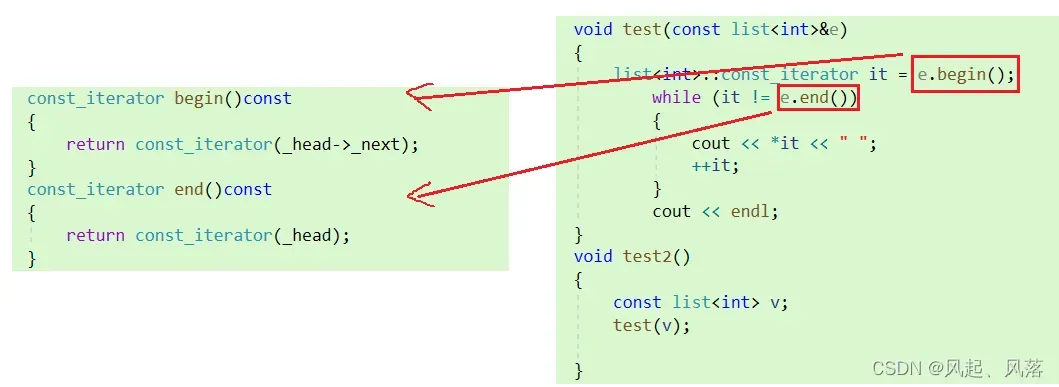
第二个模板参数Ref
迭代器和const迭代器只有 *operator 的返回值不同,
只需在模板中添加一个参数即可使用一个迭代器实现迭代器和const 迭代器的功能


第三个模板参数Ptr
对于内置类型int使用解引用找到对应数据,而自定义类型需使用->寻找下一个节点

版权声明:本文为博主作者:风起、风落原创文章,版权归属原作者,如果侵权,请联系我们删除!
原文链接:https://blog.csdn.net/qq_62939852/article/details/129440139
